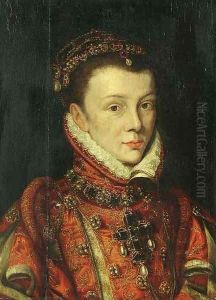Anton Mor Von Dashorst Paintings
Anton Mor, also known as Anthonis Mor van Dashorst and Antonio Moro, was a prominent portrait painter of the 16th century, born in Utrecht, Netherlands, in 1517. His early life and training are not thoroughly documented, but it is believed that he may have been a pupil of Jan van Scorel, a leading Dutch Renaissance painter who had a significant influence on the development of Dutch art. Mor's work was highly regarded for its sophisticated technique, attention to detail, and the psychological depth of his portraits.
Mor's career took a significant turn when he became a court painter to Philip II of Spain. This position not only gave him high status but also allowed him to travel extensively, including to England, where he painted the famous portrait of Queen Mary I. His work was characterized by a remarkable ability to capture the sitter's personality and social stature, making him a sought-after portraitist among the European nobility and royalty. Mor's influence extended beyond portraiture; he played a crucial role in the development of the Northern Renaissance, blending the detailed realism of the Northern European tradition with the compositional sophistication of the Italian Renaissance.
Throughout his career, Mor established himself in various cities, including Brussels, Antwerp, and Madrid, reflecting the pan-European nature of his work and influence. Despite his mobility, he maintained a strong connection to his Dutch roots, evident in the realism and detail of his portraits. Mor's contributions to portrait painting were not only in his mastery of form and color but also in his approach to depicting his subjects with a dignity and depth that went beyond mere physical likeness. He passed away in 1577, leaving behind a legacy that would influence future generations of portrait painters in Europe. His works are now displayed in major museums around the world, celebrated for their technical prowess and profound insight into the human character.
